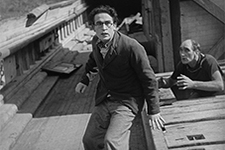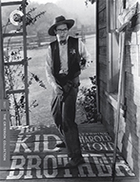The Kid Brother
|  Harold Lloyd’s penultimate silent feature The Kid Brother finds his much beloved “glasses character” in the Old West, although everything else about him is exactly what audiences had come to expect after seeing the bespectacled comedian in films like Safety Last! (1923) and The Freshman (1925). Again playing an imminently likeable, thoroughly ordinary young man named Harold, Lloyd mines the familiar storyline in which his character has to prove himself against all odds, although the story this time around eschews the typical Lloyd narrative of leaving home to make it in the big world by not only keeping him close to home, but tasking him with protecting it by clearing his father’s name. At the time of the film’s release, Lloyd was one of the most popular screen stars, especially within the comedy genre. While both Buster Keaton and Charles Chaplin are still better known and more frequently written about, they were regularly bested by Lloyd at the box office throughout the 1920s; Keaton’s brand of stone-faced irony was losing steam throughout the decade, and, while Chaplin produced hits, he was absent from the screen for years between films. Lloyd, on the other hand, who was one of the first comic actors to embrace the feature film over one- and two-reelers, was turning out one or two starring features a year. Although he was never credited as a director on any of his films, Lloyd maintained strict creative control of his projects, which is why there significant tension during the production of The Kid Brother between him and the film’s original director, Lewis Milestone (who would go on to win back-to-back directing Oscars for 1929’s Two Arabian Knights and 1930’s All Quiet on the Western Front). Milestone ended up leaving the production and was replaced by Ted Wilde, who had co-written several of Lloyd’s previous films. The “kid brother” of the title is Lloyd’s Harold Hickory, who lives in the constant shadow of his burly, widower father Jim (Walter James), the sheriff of Hickoryville, the town that bears their family name, and his two older and similarly burly brothers, Leo (Leo Willis) and Olin (Olin Francis), who generally treat Harold like a nuisance to be ignored. Harold is constantly feminized by his position in the Hickory family heirarchy, relegated to traditional domestic work such as washing dishes and doing the laundry, although it is in this realm that he distinguishes himself with clever invention (he constructs an ingenious system for laundry in which all of clothes are on a line that goes through the butter churn he has converted into wash bucket, is pulled through a press, and then comes out the other side ready to dry while held aloft by a kite). Smaller in stature and framed by his round, black-rimmed glasses and genial air, Harold is an anomaly in the uber-masculine Hickory family, which establishes the stakes of his later mission: not just to save the family, but to prove himself a “real man” in the process. The film’s gender politics are intriguing because they play squarely into traditional notions of masculinity and femininity, with Harold achieving his “manhood” (and acceptance from the other men in his family) when he proves himself through violence; yet, at the same time, the film is deeply invested in making the most masculine of characters appear consistently foolish and to idealizing Harold’s more sensitive, creative character traits. Harold’s opportunity to prove himself arrives with a travelling medicine show run by the corrupt Flash Farrell (Eddie Boland) and Sandoni, a grimacing strongman played by Constantine Romanoff, a German-born former wrestler who appeared in half a dozen of Lloyd’s films. The medicine show is actually owned by Mary Powers (Jobyna Ralston, who had starred opposite Lloyd in his five previous features), whose recently deceased father established it. Mary, who is clearly a sweet girl and not a carny huckster like Flash, immediately catches Harold’s eye, and he allows her to mistakenly believe that he is the sheriff of the town when she spies him playacting with his dad’s gun and clothes. Harold has to officially step into the role of protector and savior when his father is wrongfully accused of stealing money saved by the town to build a new dam (which allows the film to get away with written jokes about the “dam money”) that was actually pinched by Flash and Sandoni. Every Harold Lloyd feature works its way to a carefully choreographed climax, and The Kid Brother is no different, as Harold must engage in a lengthy, knock-down-drag-out battle with Sandoni aboard a derelict ship leaning askew in the harbor. On the one hand, the battle between them is a masterclass in timing, choreography, suspense, and slapstick humor, with a great gag involving Harold putting a persistent monkey in a pair of shoes to trick Sandoni. On the other hand, the sequence is surprisingly vicious in its violence, crossing the line from slapstick pratfalls into rather nasty fisticuffs (the horror-movie atmosphere of the derelict ship adds to the nastiness). Sandoni, with his exaggerated facial grimaces and hulking demeanor, is a cartoonish villain whose threats remain safely confined to cinematic tradition. What is surprising, instead, is Harold’s resilience and willingness to do whatever it takes to succeed, including taking advantage of Sandoni’s inability to swim by dragging him into the water and then trying to drown him. We’re not talking Straw Dogs or anything, but the intense physicality and and viciousness with which Harold fights back is a far cry from his comically suspenseful dangling from the side of a building in Safety Last! or trying to score a touchdown in The Freshman.The rest of the film, however, is classic Harold Lloyd, and even if some of it feels a bit familiar, it is still immensely enjoyable—the kind of the film that puts a smile on your face from the very start and keeps it there until the end.
Copyright © 2019 James Kendrick Thoughts? E-mail James Kendrick All images copyright © The Criterion Collection | ||||||||||||||||||||||||||||||||
Overall Rating: 


 (3.5)
(3.5)


